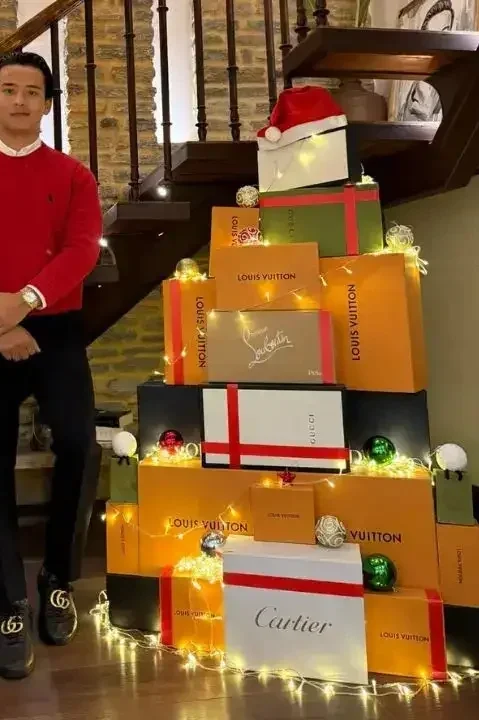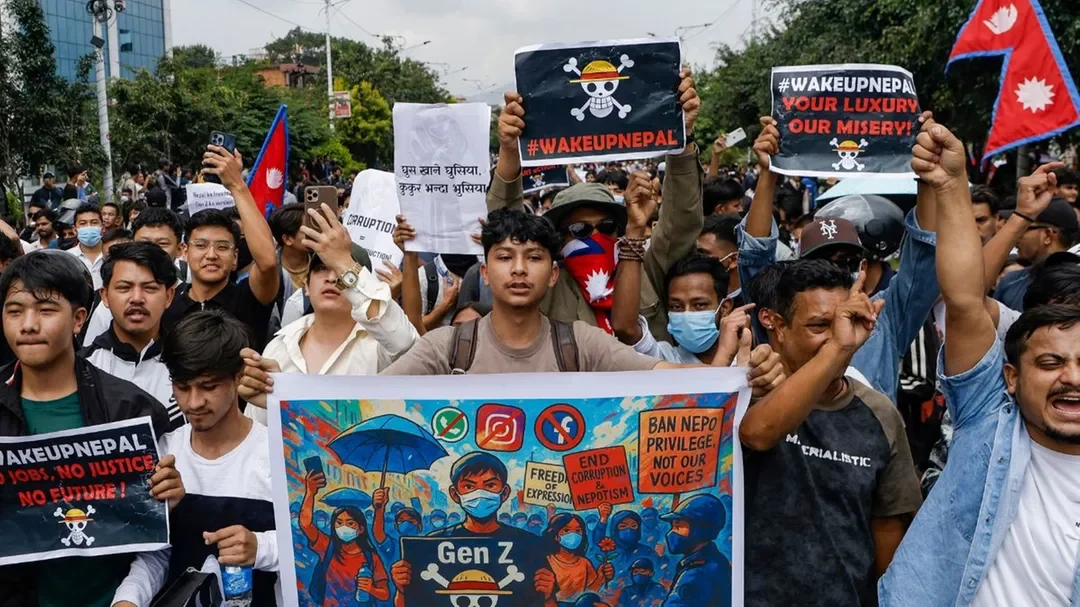Living through Nepal’s revolution
Living through Nepal’s 2025 revolution as a foreigner was at times terrifying, but very eye-opening. It taught me about humanity, power, and the kindness that exists even amongst widespread destruction.
Here I will unpack what actually happened from my perspective. Much of the international media reporting has been at best shallow and unnuanced, at worst wholly inaccurate.
Then I will explore some of the lessons I’ve taken away from the whole experience, including what this revolution means for tourists thinking of traveling to Nepal in the future.
A spark of hope,
A spark of rage.
Flames.
Nepal has made international headlines over the past few days and weeks. Protests rocked its major cities, the government toppled as infrastructure went up in flames. Living through Nepal’s 2025 revolution as a foreigner was at times terrifying, but very eye-opening. It taught me about humanity, power, and the kindness that exists even amongst widespread destruction.
Here I will unpack what actually happened from my perspective. Much of the international media reporting has been at best shallow and unnuanced, at worst wholly inaccurate.
Then I will explore some of the lessons I’ve taken away from the whole experience, including what this revolution means for tourists thinking of traveling to Nepal in the future.
What happened & why
The only way I can describe the situation is an “unintentional revolution”. I’ve seen some media claiming it was highly effective and organised, which is not true. There were a series of dominos that fell, leading to the collapse of Goverment and, briefly, normality.
The domino playing board: Nepal’s broader context
While it is a beautiful country known for its snowy mountains, what tends to strike travellers is the kindness and hospitality of its people. Nepali culture is to be welcoming and generous - even though many do not have their needs for healthcare & education met.
Corruption in the political system has meant funds never reach intended projects, or arrive severely diminished. As a result, healthcare, education and infrastructure are lacking - especially for Nepal’s poorest and rural communities. The need to fund these things privately has driven many Nepalis abroad to find work, disrupting social connections in a society where family is central.
Nepal’s relatively new democracy has arguably not worked that well, with three leaders of three political parties rotating through power and without much changing.
Domino 1: #NepoBabies
On Nepali social media, a trend calling out “Nepo kids” went viral. This highlighted the children of politicians and those in power, who posted photos of themselves showered in luxury that most Nepalis couldn’t even dream of. An example is a Christmas tree made from a pile of branded shoeboxes and bags.
The Nepo kids trend put stark visuals to the usually hidden issue of corruption. It demanded an answer to the question: why do they have so much, while we have so little?
One of the images that circulated as part of the #Nepokid #NepoBabies trend
Domino 2: Social media ban
The Nepal Government announced that social media would be banned in 3 days time, if the platforms didn’t register with the Government beforehand. The list was long and covered all of the platforms Nepalis use for daily communication with family.
As expected, most platforms didn’t register. Then over a few hours, the ban was rolled out - first we couldn’t load on wifi, and then even on cellphone data.
Of course, a ‘ban’ on anything online is quite hard to do. The young tech-savy, English speaking population install VPNs for themselves and their family members. Those in rural areas, or with family abroad working were cut off from their means of communication with family or with potential incoming tourist visitors.
Officially, the ban was proposed to ensure the platforms were taxed and regulated. Others speculated it was to limit free speech, or even to shut down the #NepoKids criticism. A similar ban on tiktok had been implemented briefly a few years earlier and that was speculated by some to be because of videos circulating about Ministers relating to a scandal.
One thing was telling. Despite the ban, the Prime Minister continued to post on his social media.
The banned platforms. I didn’t recognise half of them!
Domino 3: slowly loading frustration
The days leading up to the first protest were strange. The energy in the city was off. Perhaps the collective conscious was becoming frustrated because the internet was painfully slow, even for Nepal. The strain of everyone using a VPN almost broke the internet. We couldn’t do basic things like order a taxi on an app - using wifi or data.
We had a series of bizarre events and run-ins, one of which was so disturbing we called the police. We felt tense and on edge, like the hour when a thunder storm is brewing but the rain hasn’t yet started.
Domino 4: peaceful protest turns deadly
In response to the ban and the general issue of corruption, ”Gen Z” took to the streets in their thousands. They wore school uniforms, carried memes and One Piece flags.
Photo credit: PTI
In the afternoon, reports of the first death came - again via banned social media platforms. After the first, came more and more. The young people, some students in school uniforms were being shot with live ammunition. Killed with wounds to the head. There are many very graphic videos that circulated on social media, which I will never forget but I won’t describe here. You don’t open fire on kids, you don’t shoot unarmed schoolchildren in the head. There is simply no justification.
The death toll climbed. The awful videos on social media circled. Finally, the thunder storm had broken. Nepal’s collective heart was stuck by a lightening rod of pain.
Darkness fell and people left the streets. But that night, the nation didn't sleep. It rested under a blanket of heavy grief, tossing in anger. People had no words to express their rage, their sense of injustice.
Domino 5: Government misses its chance
The Government had one evening to come together with a response to the tragedy, bloodshed. To show up and acknowledge the rage of the nation, and try to find a way to make it right.
The only thing that happened was the resignation of the Home Minister. Late night it was also announced that the social media ban was reversed. Fair to say, it was insufficient. The response was out of touch with the scale of injustice and depth of feeling of its citizens.
What came next was inevitable.
Revolution
We got some supplies early morning (nothing major happens in Nepal until 10/11am) and then settled in to stay inside. What I know about this day is purely from watching on (still banned) social media. Everyone was filming and posting online.
Sure enough, from mid morning, people flocked to the streets. There was a lot of Gen Z but there was also every generation. They were hungry for revenge, tired of the Government’s empty words and inaction.
Photo credit: People’s dispatch
The police had lost their moral authority the day before and became veritable targets for people's rage. They were overpowered and totally lost control. Unfortunately, several were killed. Even the poor traffic police (who I think have the WORST job in the country, standing as human traffic lights in dust, fumes, rain, and heat all day long) were targeted by angry citizens.
I think first to go were Ministers houses. Many were set alight. Scores of bank notes were flung from their roofs, hammers, stones and feet were taken to their contents. Some Ministers and their families were attached. The army flew in with helicopters to rescue Ministers and flew them to saftey, as their old lives burned with the anger of a nation.
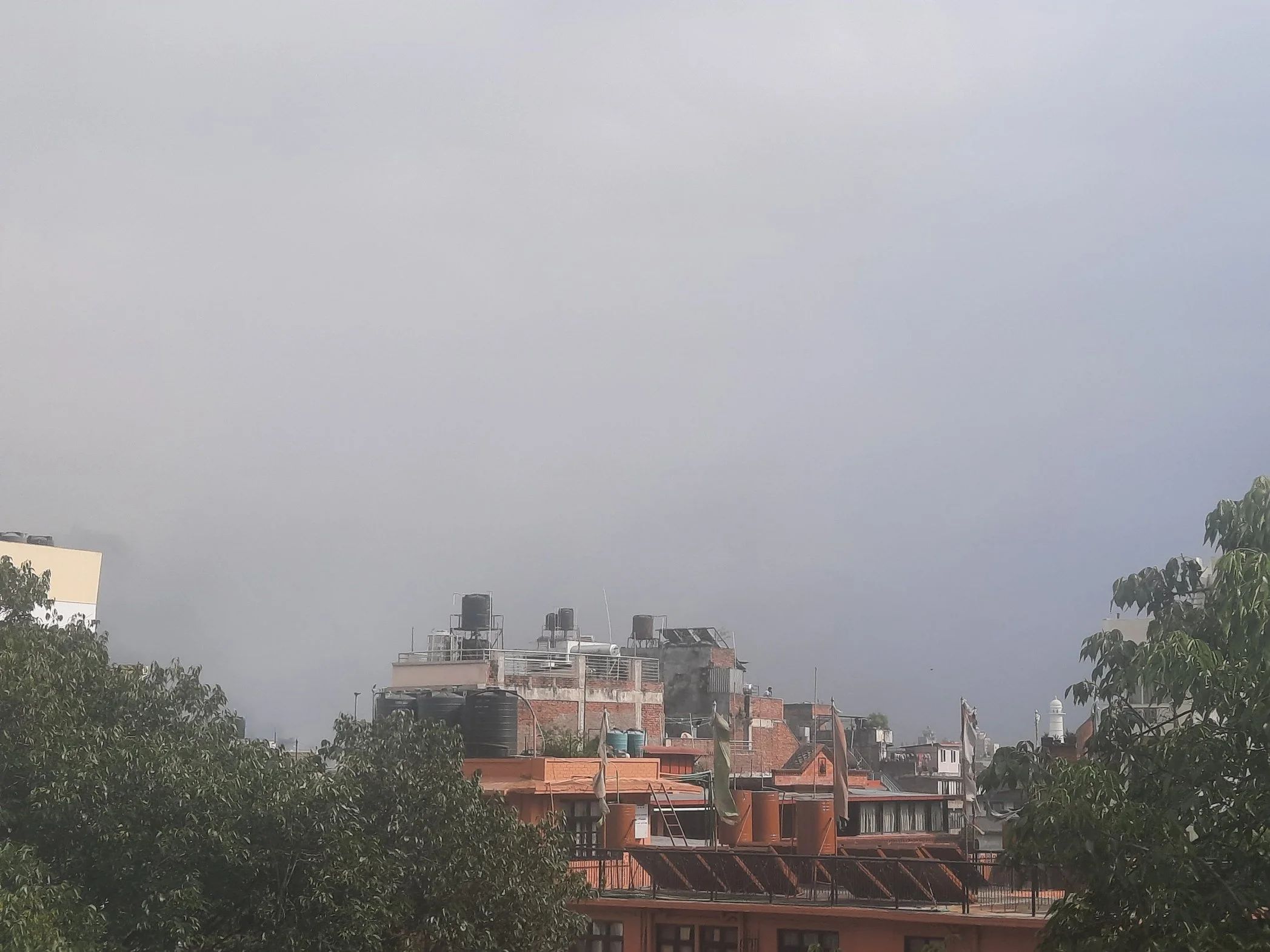

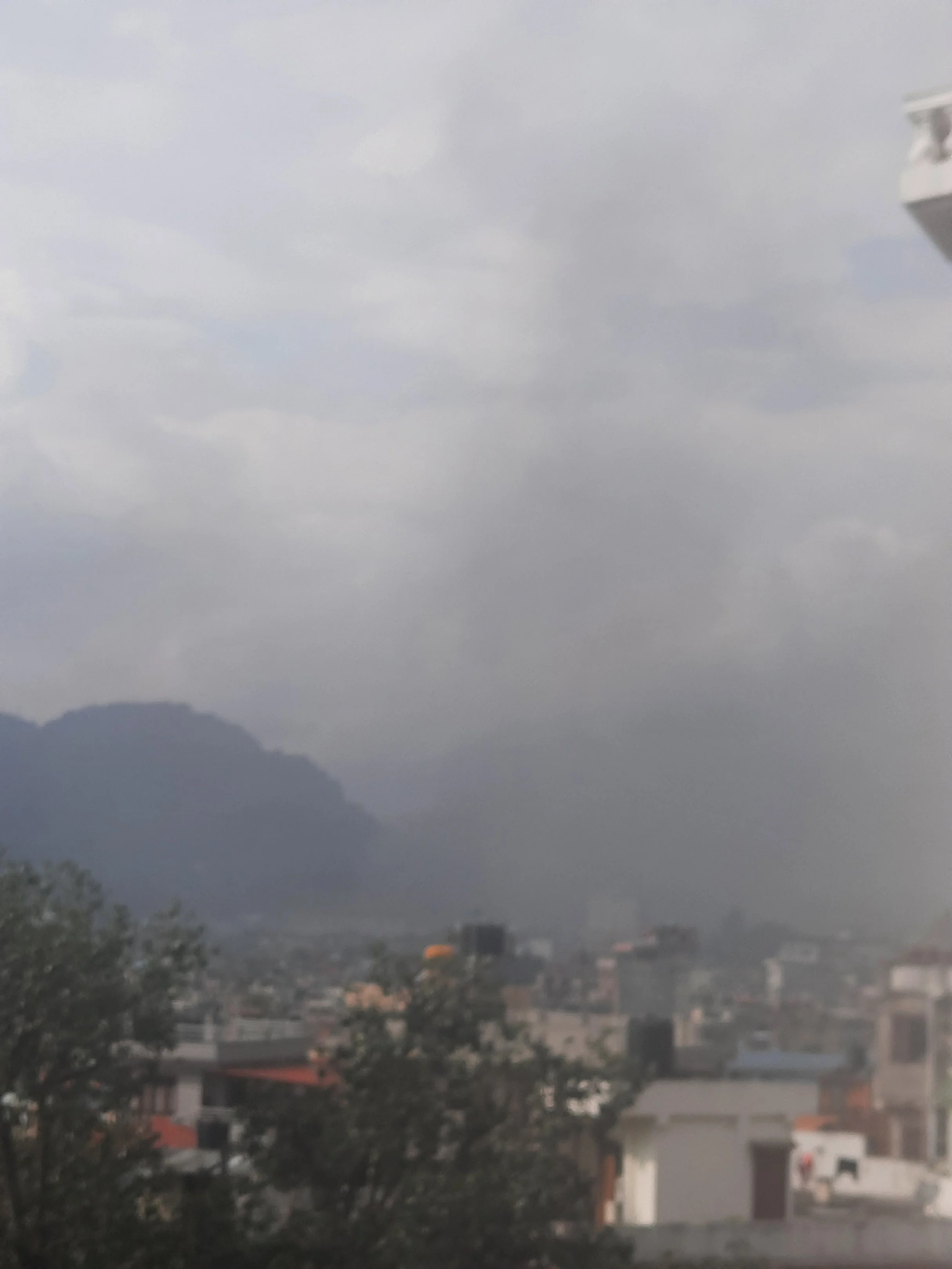
Then various public buildings copped the mob’s rage. The Parliament building, that Police had used lethal force to defend the day before? Wrecked. Its stone and metal fences destroyed by hand. The building burned and graffiti-ed.
The Ministry of Roads, Ministry for Health, Kathmandu district court, Police stations, police fleets. Ambulances were also targeted, and I heard this was due to protesters - rightly or wrongly - thinking politicians had hidden inside some of them to get transported to safety.
Several other buildings - shops, hotels, private schools were set alight. I had felt started to feel unsafe when I saw hotels on fire, until I found out that it was targetted because people believed they were Ministers’ investments, not out of anger for tourists being in Nepal!
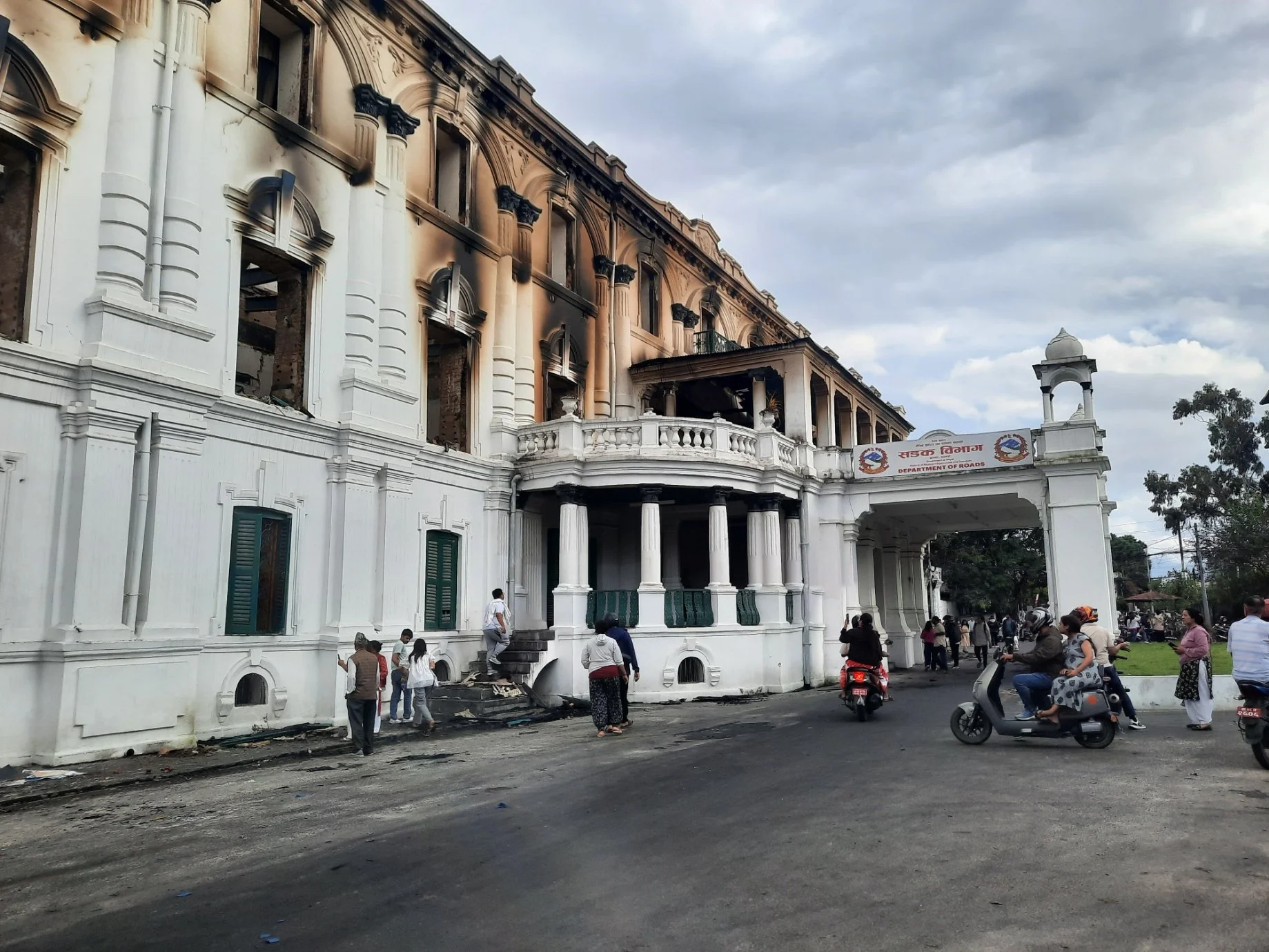
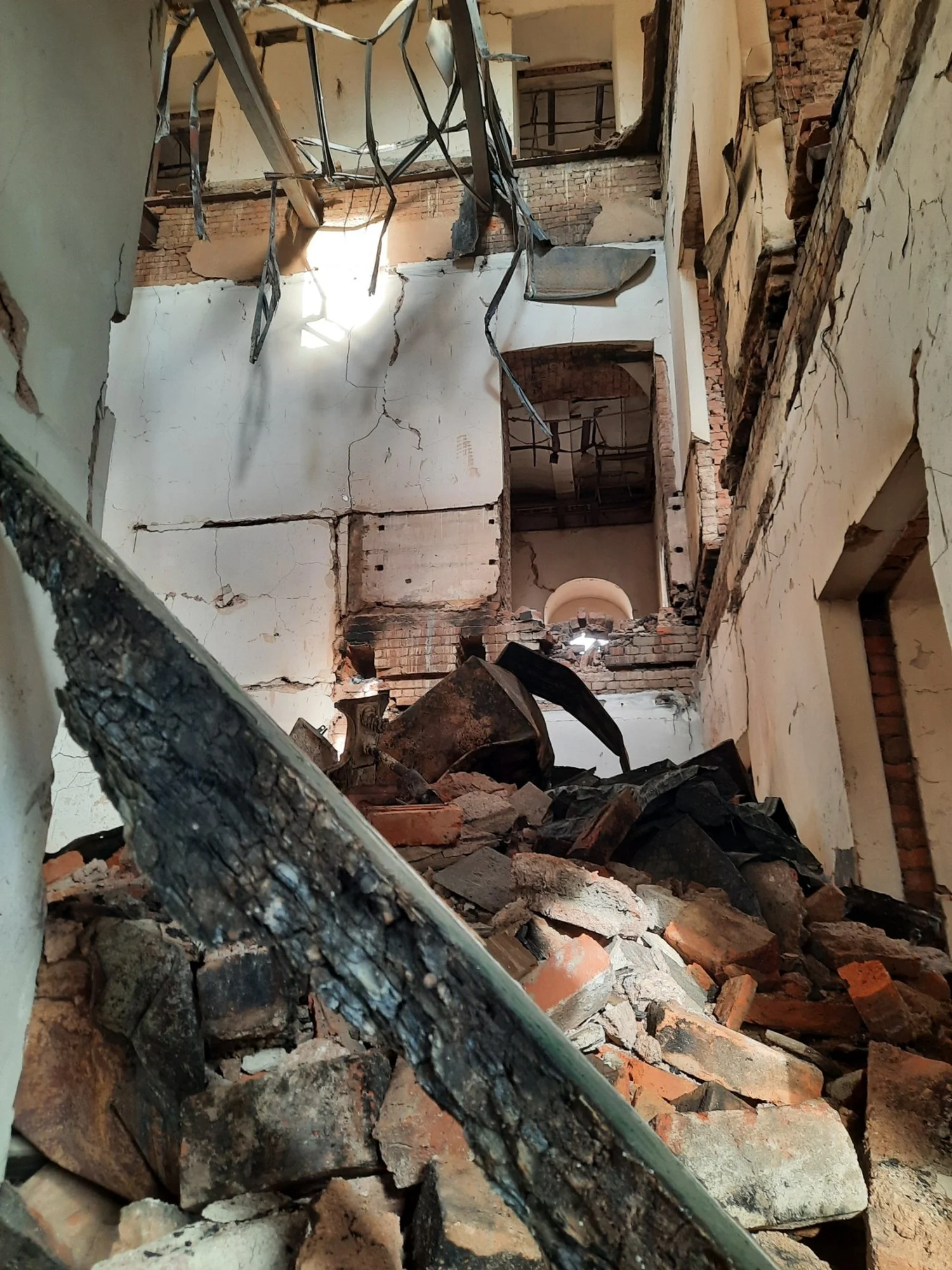
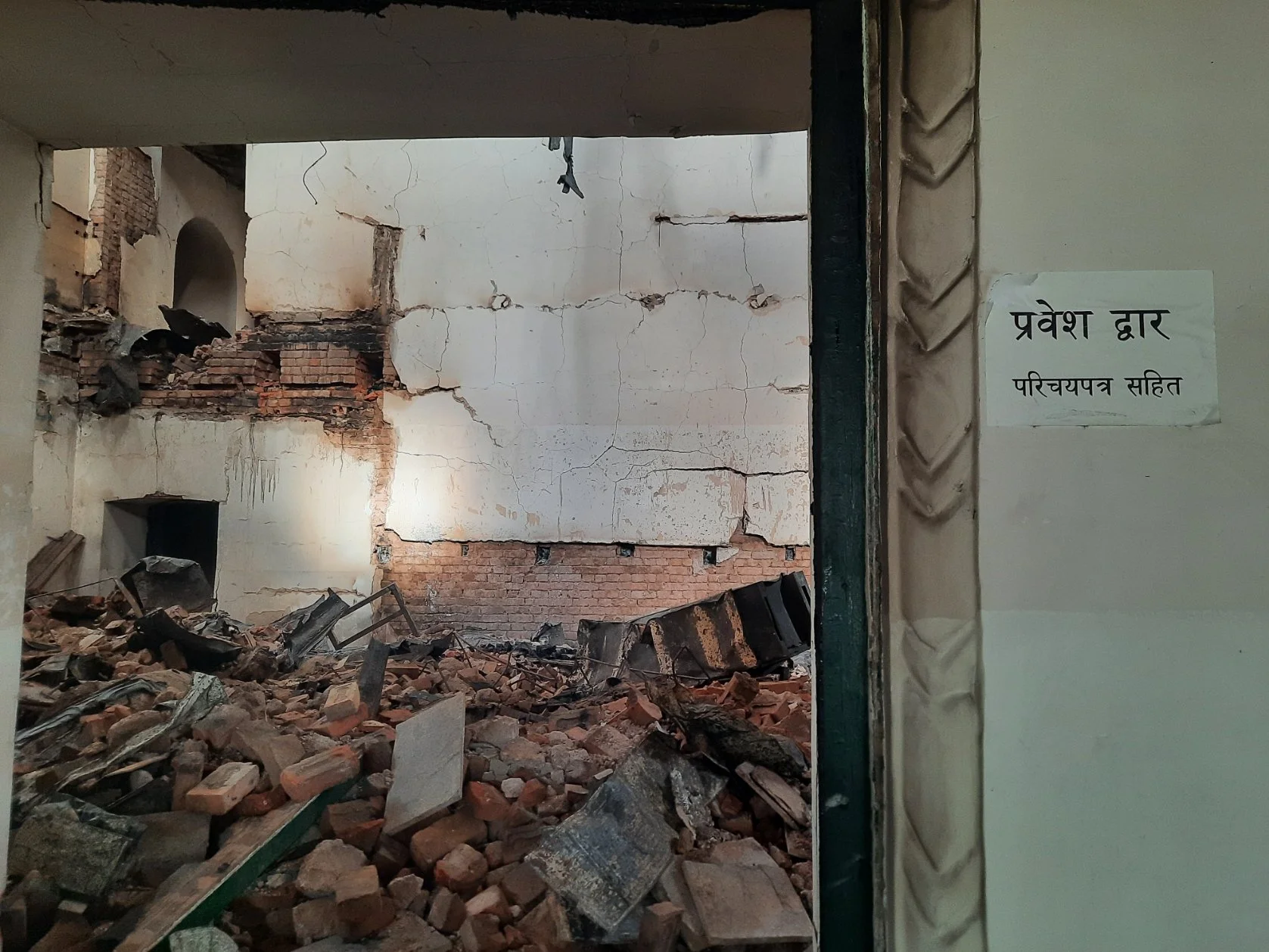
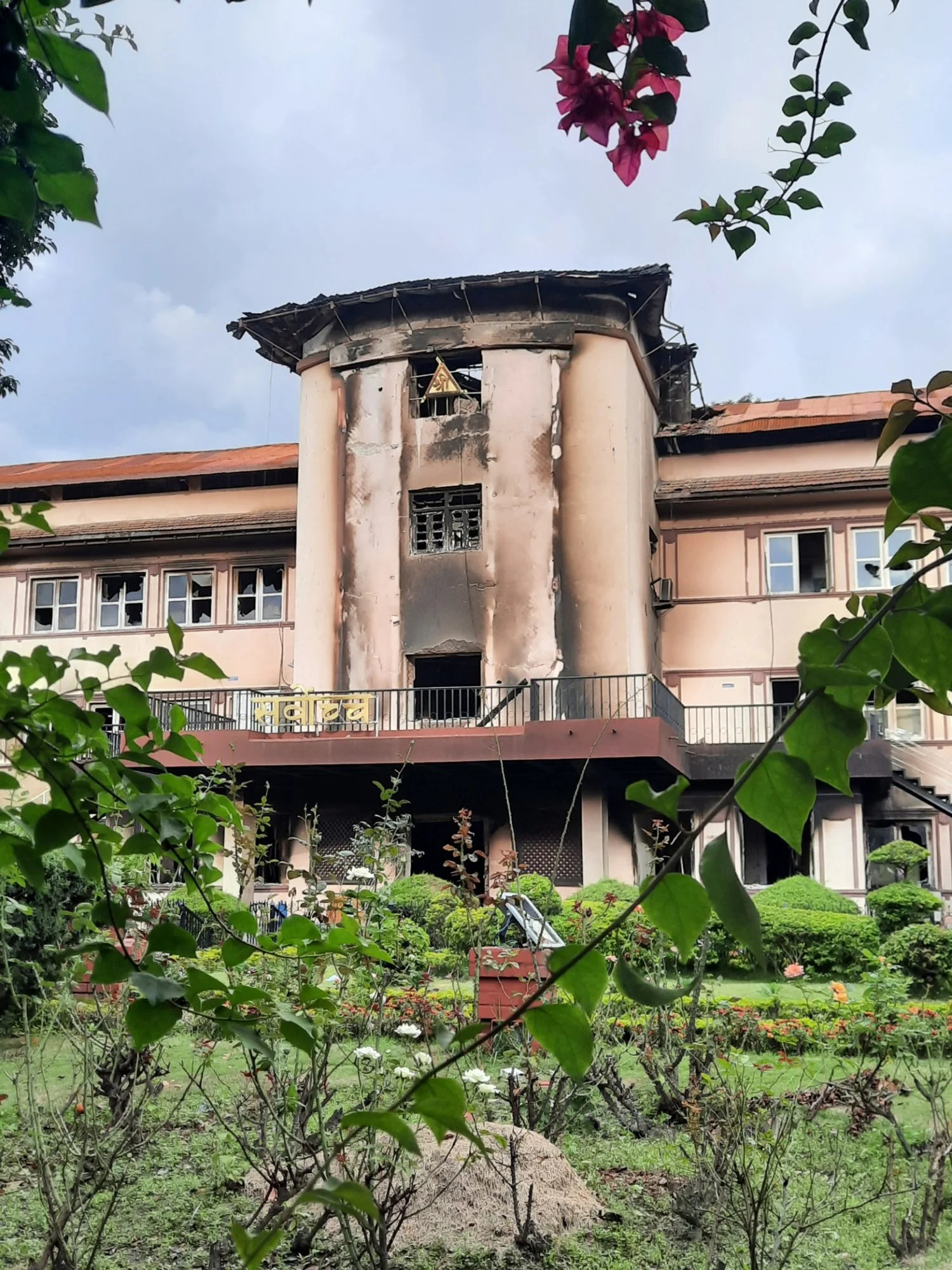
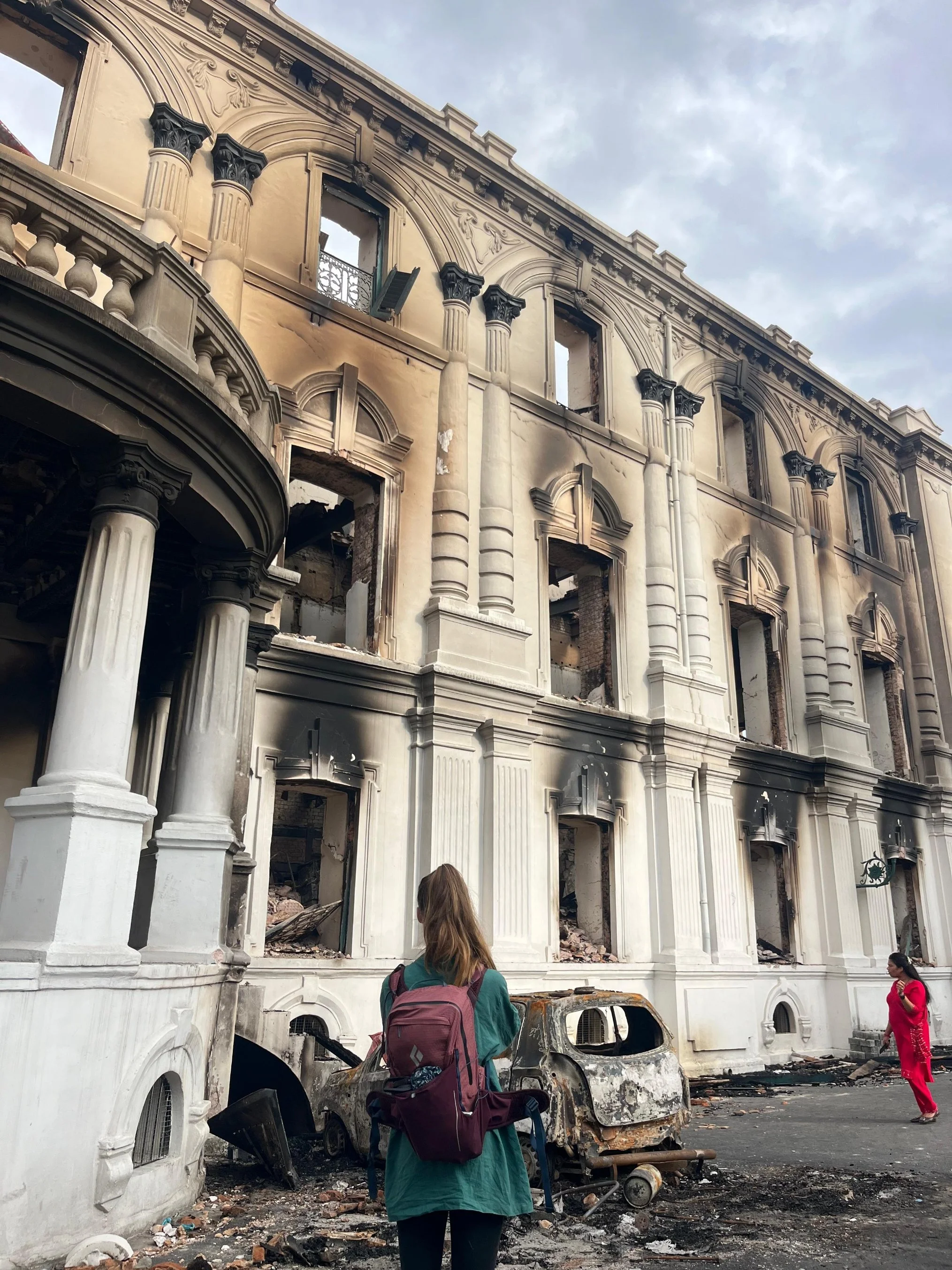
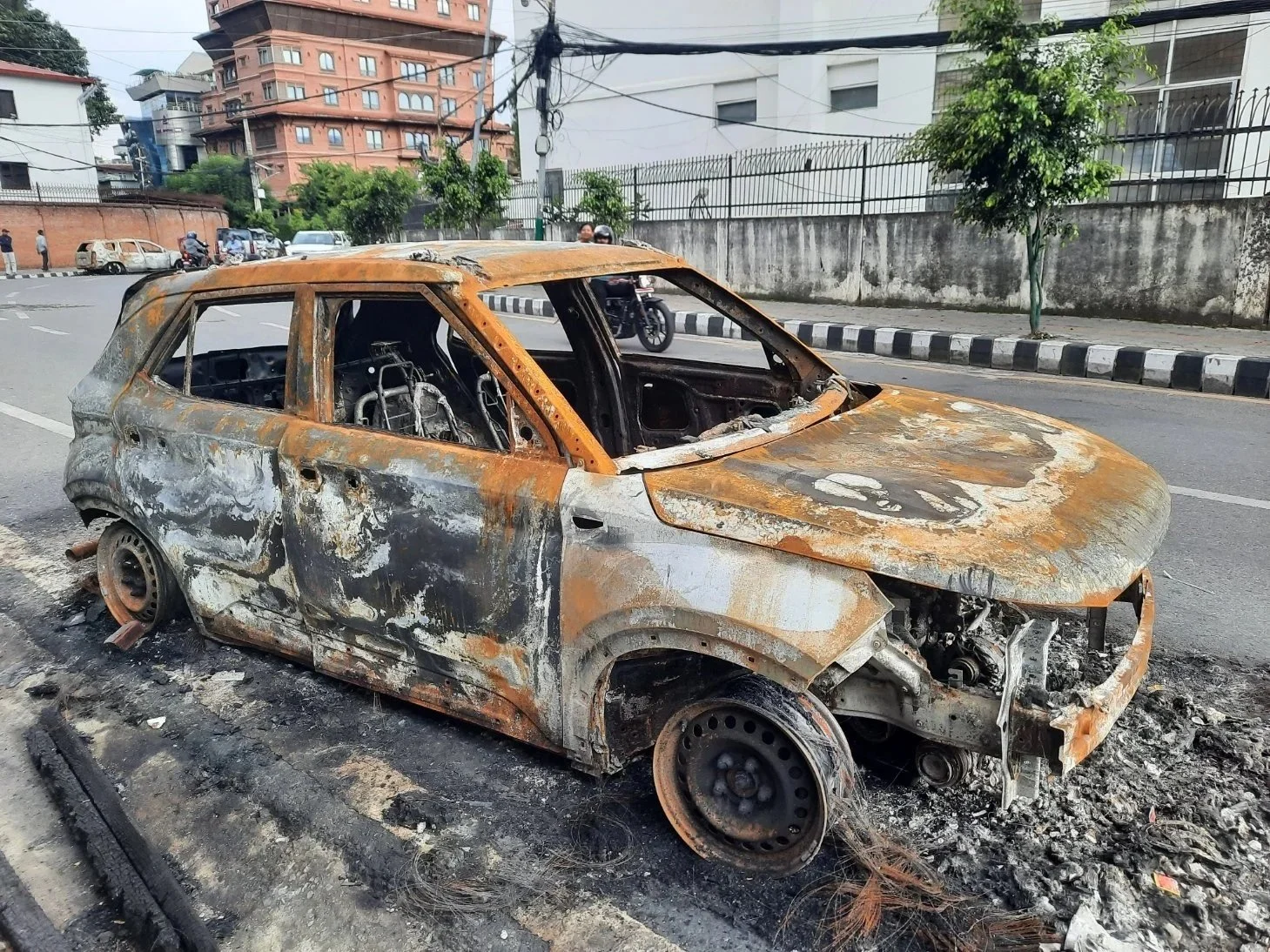
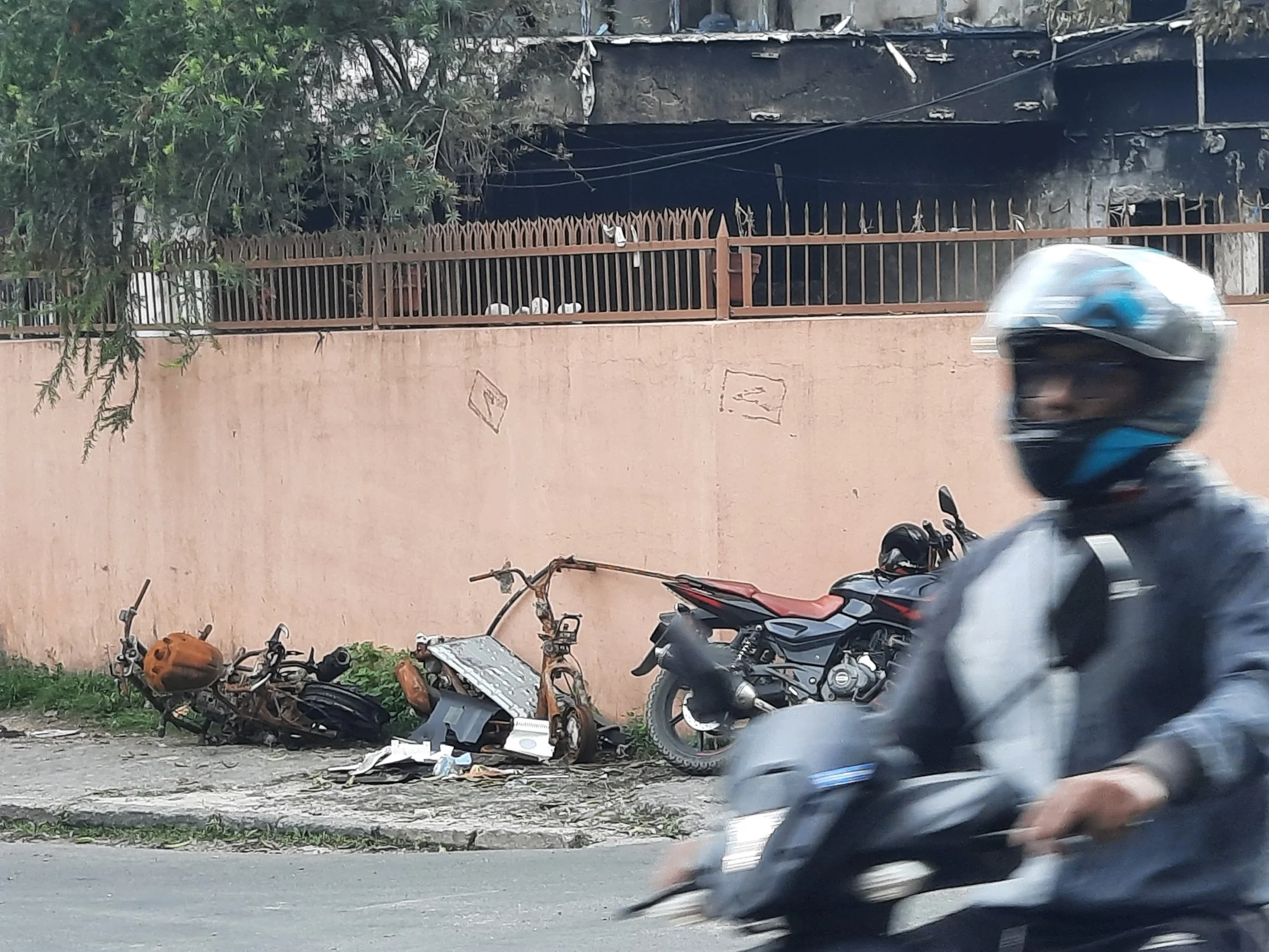
Last to go was the glorious Singa Durba, which was once considered Asia’s largest palace and a testament to the Rana dynasty’s wealth. The building had only just been painstakingly restored with historic architecture and building techniques, after the earthquake.
Anarchy
Leading politicians, including the Prime Minister resigned in the early afternoon. The police force was absent. There was no messaging or presence from anyone in the Government, the President, the police, the army, or anyone in authority.
Elated by their new-found power, many of the protesters had parties in the streets. They danced, played games of UNO, drove at speed on their motorbikes, slid around on wheely office chairs from burned offices while pretending to call each other on uprooted office desk phones.
Kathmandu and other cities briefly descended into anarchy. People looted guns from the Police, and were walking and driving around with them. We heard gunshots, which I think was from people firing into the air. I didn’t hear of anyone using these weapons on each other.
Prison breaks occurred with thousands of inmates escaping.
The anger turned outward from just political, with the rich and large companies being targeted next. The only major supermarket and department chain was targeted, stones thrown, aisles collapsed and goods taken. It was strange to see what people chose - many people took large teddy bears, others just one bottle of alcohol.
One of the biggest companies Chaudhary Group cars and warehouses were burned, car shops went up in flames. News and cellphone network providers building were burned. Then ATMs and banks were looted and burned.
In coming days, there were allegations of political interference and opportunism. Noting that only certain political parties’ offices and structures were burned - while others remained untouched.
Army rules
By the early evening, public opinion (at least on social media) had shifted. The destruction had gone too far.
The army announced - on its newly formed social media channels - that they were going to be on the streets from 10pm. “Go home”, they said.
Power vacuum
Over the next few days, there was a hint of relief and hope, on a backdrop of uncertainty and fear. The army held control of the streets and curfews were in place. The chief of the army asked “Gen Z” to come to the negotiation table with the President.
But unlike what you might expect from an organised revolution, “Gen Z” wasn’t a cohesive group with a leader. It’s not a political party or entity. It was a generation. Leadership was ambiguous and fractured. The “Gen Z” in the protest also wasn’t representative of the whole country - just a subset of youth living in major cities, mostly male, and generally more educated and wealthier than Gen Z youth in rural Nepal. This was a concern to some commentators.
Nepalis who had lived through the Maoist uprising were nervous about the level of army’s influence, remembering the terror of being caught in cross fire or family members disappearing overnight. The army’s communications were the best out of any part of government - actually almost the only communication.
The ambiguity and unease was deepened by concerns that the constitution would be breached, possibly leading to further civil unrest.
Yet over just a few days, an interim Prime Minister leader was nominated by “Gen Z” via a discord poll. Sushila Karki, Nepal’s first women prime minister and former chief justice was sworn in late on Friday night - 5 days after the first protest. She is to remain in office until elections are held in 6 months’ time.
I was nervous protests may continue, as there had been some violent clashes between people who supported different interim Prime Ministers.
Watching the interim Prime Minister being sworn in, from my laptop in bed
However, the new Prime Minister started by visiting injured youth in hospital, inspecting damage, and responding to calls to give martyrdom status to those who had lost their lives in the protest as well as financial support for their families. She then appointed a number of Ministers, mostly those who had been high up in the civil service, and (like her) had a track record of calling out corruption. It seems as though public support, or at least a degree of public patience, is behind PM Karki. Hopefully this remains and the upcoming election goes smoothly.
What’s next for Nepal?
I don’t know what is next. Rebuilding Nepal to be the country protesters hope for is a long path. I have found hope and inspiration in the following excerpts:
“We cannot believe that one leader can erase decades of betrayal. Nor can we believe that anger alone will carry us forward. If we want a different Nepal, we must practice discipline, embrace nuance, and resist the alienation that power and capitalism thrive on. We must educate, agitate, and organize—not just for a season, but for a lifetime.
Revolutions are never pretty, but they do not have to be hollow. If we hold complexity, resist alienation, and build hope as a discipline rather than sentiment, then maybe this time the fire will not just burn us. Maybe this time, it will light the way.”
-Simoni Agarwal, Lipstick Politico
Graffiti outside the burned Parliament building: "Save the Constitution” and “Long Live Democracy”
“Democracy is a responsibility to act to build a good country. A good country is built on its communities. Communities are built on inclusion, kindness and connection…
Taking [the interim Prime Minister’s swearing-in oath] as a win could be dangerous. It could blind us to the work that must be done. It is not glamorous or easy work. It is the work of showing up, being kind, helping, building, debating, including, voting… When we can do that day in, day out - that is when we will have won.”
-Ashim GC, Instagram
My personal experience
Living through this felt very déjà vu. It was similar to the COVID-19 pandemic, where everything you thought was solid and certain was suddenly proved to be an illusion.
What is left, when all the structures and certainty is stripped away? There are only things that are more conceptual and “fluffy”- integrity, kindness, friends, connection. These things are “infinite values” that society often place less importance than “finite values” - like money and possessions.
It was for sure a stressful time, primarily because Nepal has become one of my homes an I care deeply about the place and people. But I spoke to tourists who found the curfews inconvenient, but otherwise were largely unaffected by the chaos (some even enjoyed it).
The two things that shook me the most were when a sense of humanity seemed to be abandoned. Firstly, the killing of young people with bullets. Buildings can be rebuilt, but lives once gone are lost forever. Then, on the second day, some Ministers and their families were attacked, beaten, degraded, and publicly humiliated. I think similar may have happened to some police officers but I’m not certain. The cruelty of it really upset me.
Kindness always shines through
Despite the anarchy, destruction and some cruelty - kindness shone through the chaos. Some of the more heartening aspects of the day:
Neighbours looked out for each other.
Just down the road, the local community apparently stopped the police station being set alight because it was right next to an old people's home.
Communities stood watch over historical, cultural and religious sites to stop them being destroyed.
Friends checked in on each others’ wellbeing.
People stood outside department stores at ATMs, demanding looters to return stolen goods.
Protestors chatted with and looked after a foreigner exploring the streets.
A dog was passed out of a house before it was set alight, and a paralyzed woman was carried outside to safety
In the days after the protest:
Youth took on the role of traffic police in their absence
Communities welcomed back the police force with flowers and food
People cleaned the streets and burned offices
Volunteers help to paint and rebuild
Is Nepal safe? Can i travel there now?
A lot of people have been asking this question. From my point of view, as a foreigner, I didn’t feel personally unsafe in Nepal. There are some countries where tourists or expats are specifically targeted, but this is not the case in Nepal.
It would be possible to have been hurt if you were in the wrong place - like out on the streets protesting. Definitely DO NOT attend a protest outside of your own country. Or in the few hotels that were burned. To the best of my knowledge, no-one in those hotels was harmed by the fires.
Hospitality amidst the protest
The Nepali concept of “guest is god” means foreigners are often showered with warm hospitality. Notably cases stand out:
A protest crowd parted to allow a tourist coach to pass through
A British tourist went around Kathmandu exploring the protest, and received a lot of support and kindness from the protesters
The local government put on extra security throughout the tourist centre of Kathmandu
Nepal’s Tourism Board ran shuttle busses to and from the airport for tourists as normal transport was disrupted
Those with travel documents were allowed to go to/from the airport despite curfews
A video of the protest crowd waving at a tourist bus and parting to allow it to pass
The situation now
In terms of the situation now, it is calm. Oddly normal actually! It always was calm in key tourist areas like Everest and Annapurna; only the cities had large protests.
If you are up for traveling to Nepal, the hospitality you’re likely to receive will be next level. Nepal has lost so much economically and really needs income from tourism.
Guides and porters are without work. Companies are struggling. Reports are of losses of 40% in some parts of the tourism sector. The protests came right at the start of the new tourism season, following the off-season of monsoon. So the sector is facing potentially 9 months or more without income, if this season does not go well.
Common sense safety tips for travel
When travelling, it’s always best to be prepared. After all, a major protest can occur in any country with limited warning (recent protests in France are a case in point).
Some common sense tips include:
Ensure you have a comprehensive travel insurance
Register your overseas plans on your government’s travel/living abroad register
Keep some cash handy, in case online payments and ATMs do not work
Have some snacks and drinking water supplies
Follow local social media pages for news updates*
If the news in another language, you can use google translate (even if it is text on an image format)
Stay away from any protests
Talk to locals to understand for information and to understand any risks (e.g. hotel staff, shopkeepers)
*some of the Instagram/Facebook pages I follow to stay up to date with local news in Nepal: Routine of Nepal Banda, 24 Ghanta Nepal, In depth Story
Ladakh: where mountains meet moonscapes (and everything in between)
Trekking in Ladakh is full of contradictions. It is remote, but there is human presence and history everywhere. It is barren and desert-like, but holds an abundance of life. The living landscapes look too beautiful to be real - as though painted by the most talented artist.
Trekking in Ladakh is full of contradictions. It is remote, but human presence and history is everywhere. It is barren and desert-like, but holds an abundance of life.
While trekking in Ladakh, it felt like one of the most remote places I’ve ever been. In other countries I am used to carrying a GPS device in case of emergencies. However, due to strict regulations, these are not permitted in India. We were aware that we were on our own and must take care of ourselves.
We walked for days without seeing any other humans. Yet at the same time, there are constant reminders of human presence. There are mani walls scattered all over the landscape, their prayers carved into slate rocks, angled to the heavens like solar panels.





On top of hills there are now-crumbling forts, blending in perfectly with the shapes of rocks and hoo-doos. Old shepherds’ huts dot the hillsides, now roofless and crumbling and there are occasional traps for snow leopards, wolves and foxes (though none were active).
The landscapes are vast. The rocky slopes are rugged and rubbly - their shingle, scree and boulders all somewhere along the process of falling into the valley below.
Despite it being primarily rocks, the colours of the landscape made me question everything I know about rocks. Some are grey and boring - but many give the landscape vivid colours - purples, pinks, greens, whites. And other inspire the imagination with their weird and wonderful shapes - dragon spines, faces, a thumbs up, a stupa, fort-like structures.
At first, it seems completely barren. Then, something moves and I realise there is an abundance of life hidden between the rocks.
It is incredibly dry - my lips chapped and we easily got dehydrated under the glaring sun. But at the same time there was copious amounts of water - snow melt from the mountains surrounding us.


Even so, the water was mostly unusable because as it raged down from the heights above, it picked up so much sediment that the valley rivers were opaque and muddy. We camp near freshwater springs or small side streams each night, chosen by our horsemen.
As for the trekking itself - we had short, relatively easy days (in terms of kilometres walked). And even better, we didn’t need to carry large amounts of heavy gear for camping, because our lovely train of horses carried most of the load. At the same time, the high altitude often made the going tough, especially high passes over 5,000m!





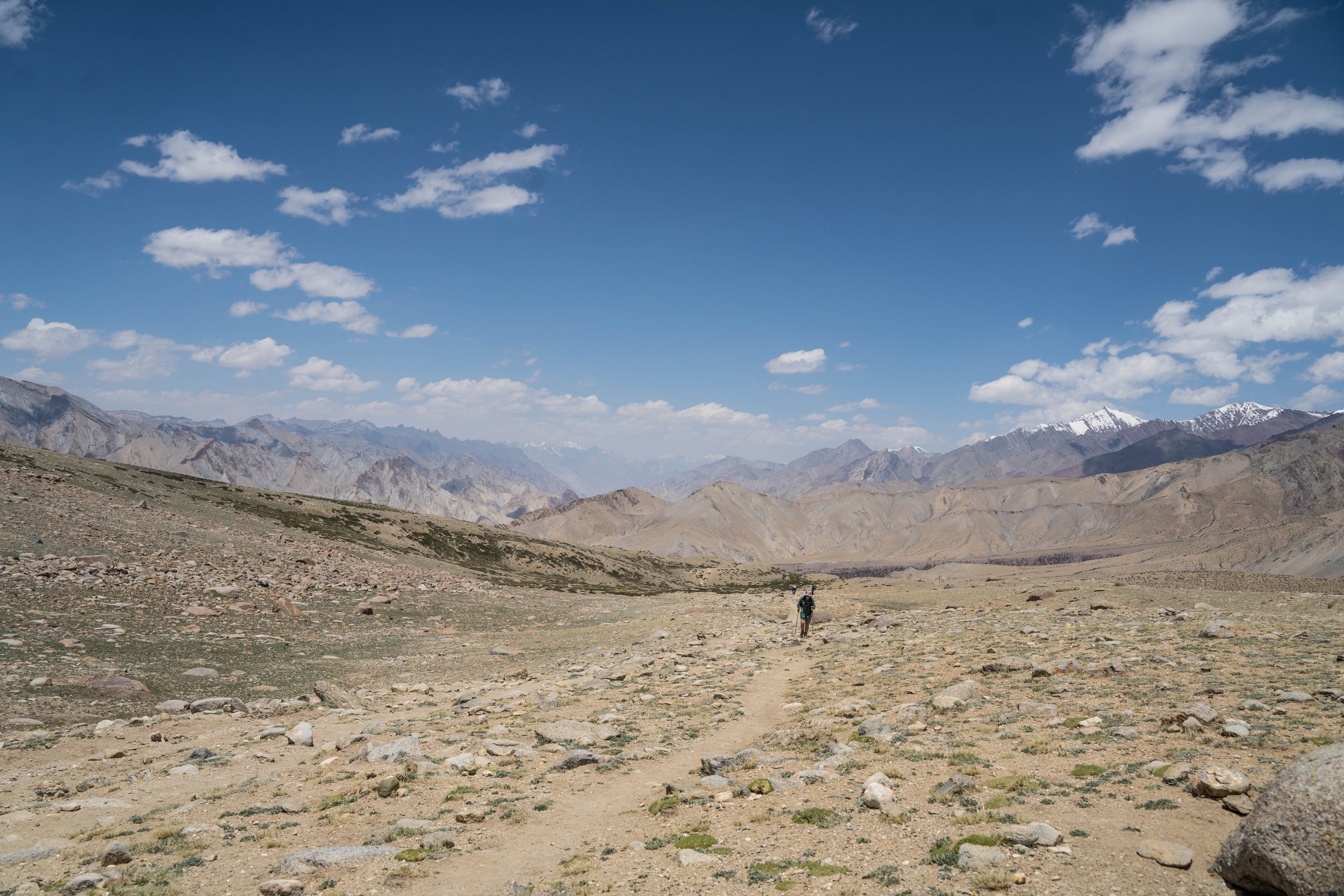
Despite feeling the thin air, it was definitely worth the exertion to see the landscapes in front of us. They were so vast, so rugged, so multicoloured, and so perfect I often felt they must be painted - because they were too beautiful to possibly be real!
It’s not unusual to feel this once or twice during a trek, but multiple times a day is rare. Ladakh truly is a special place to walk through.
Paws, wings and Peaks: wildlife wonders in Ladakh
Despite the rugged landscape, wildlife in Ladakh flourishes! Meet the characters we spotted on our trek - from cute and cuddly to acrobatic daredevils.
Ladakh’s landscapes are rocky and barren. Could there be wildlife in such a vast, rugged desert? While I was trekking through the different coloured rocks and dusty valleys, it often seemed impossible.
Then… Something moves! Suddenly it looks like a patch of the hillside is moving. Is it haze from the heat? A trick of the light? No - it is a rare herd of blue sheep!

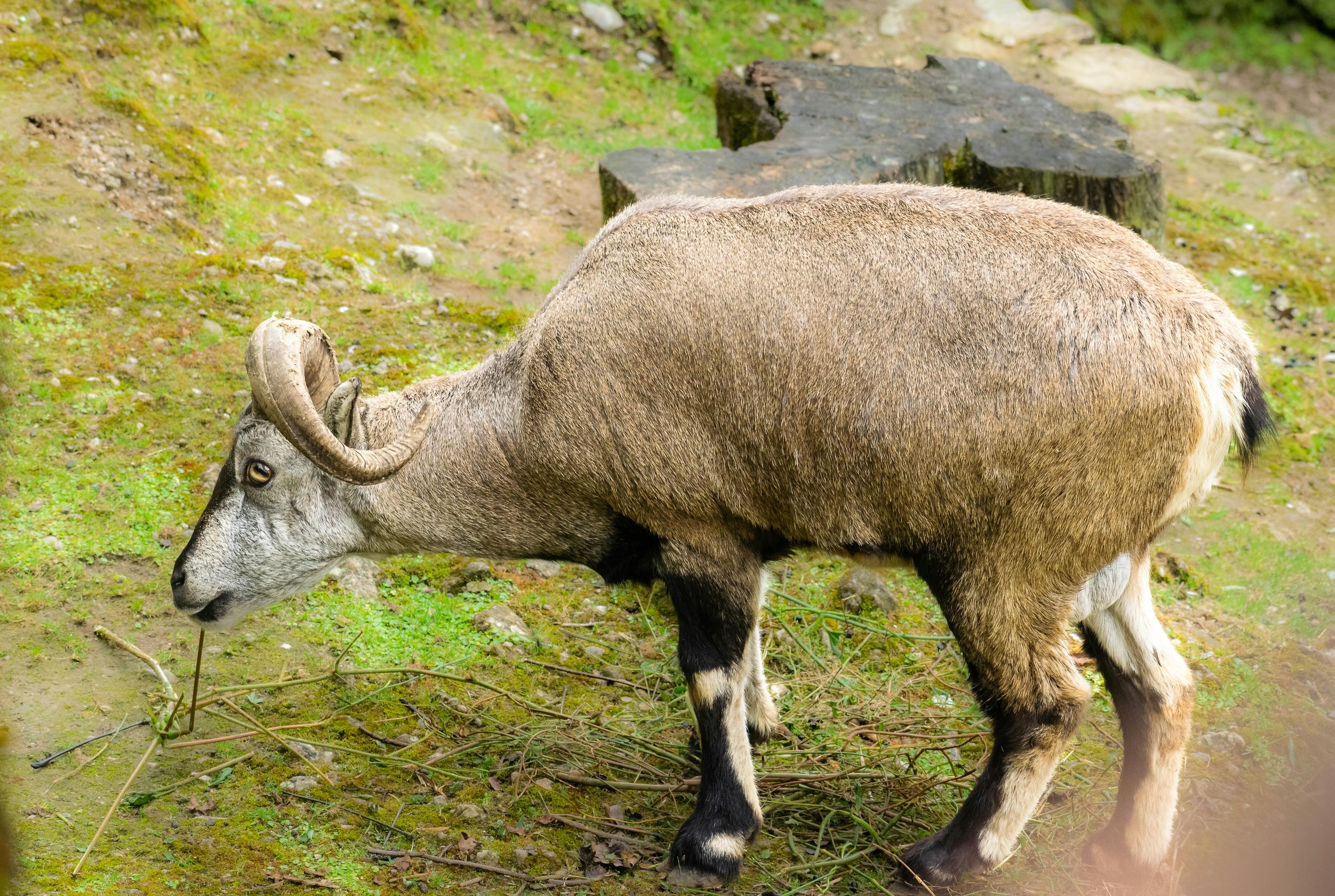
The name ‘blue sheep’ isn’t quite accurate. They are actually goats, and more of a grey colour than blue. One stands on the ridge, its perfectly still silhouette looking like just another oddly shaped rock. Another stands perfectly still halfway up a cliff, blending in perfectly with the rocks behind. Then it breaks - bounding gracefully down the near vertical cliff face and bounding onto the scree below, releasing a cloud of dust.
The seemingly barren landscape supports other wildlife, too.
The cute Pika rodents were a common sight to see while trekking in the Markha Valley, but their shrill warning calls were heard even more often. During summer they collect and pile up grass to see them through the harsh winters. Although it was only the start of summer we saw some already impressive piles outside their burrows.

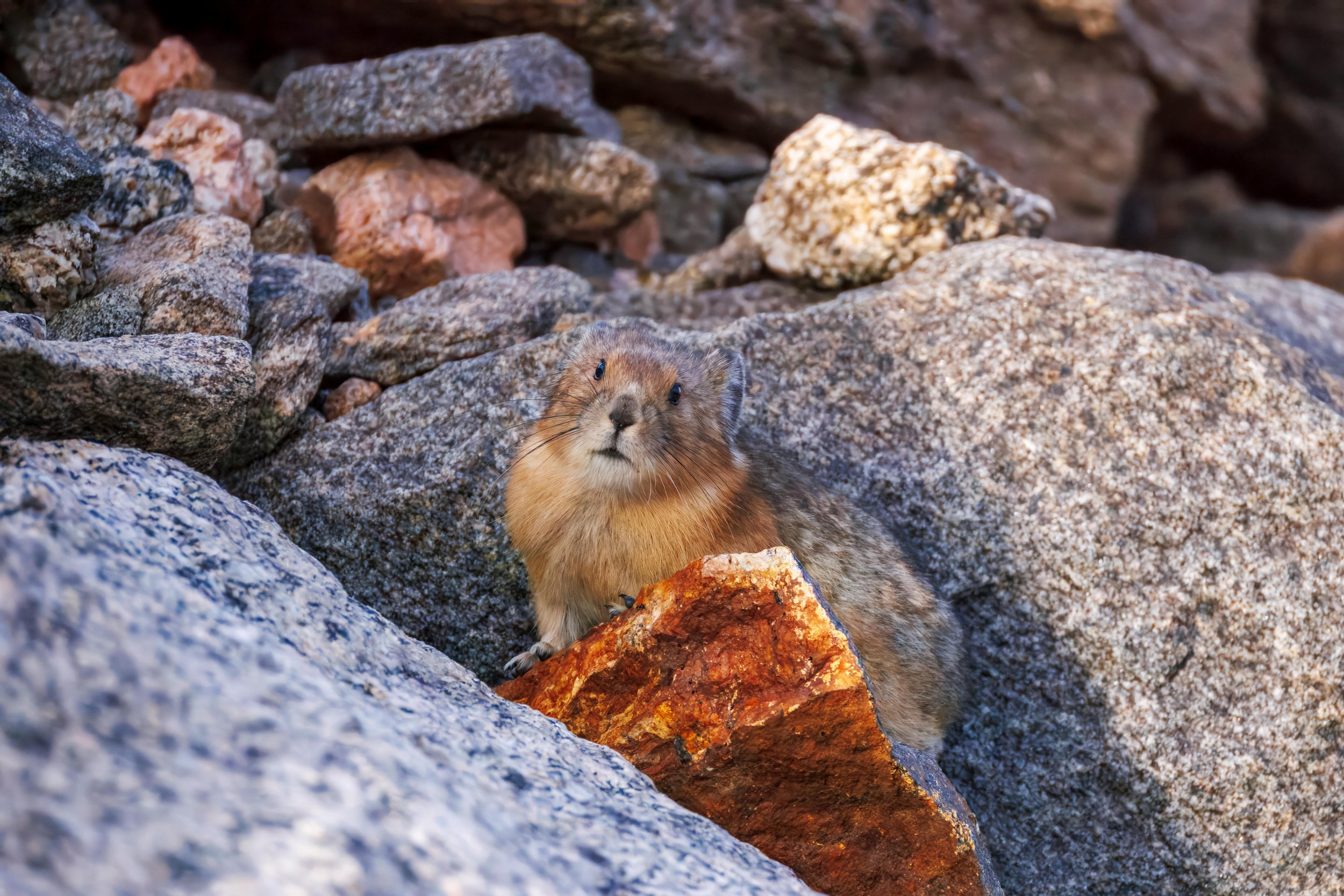
Cheeky cubby marmots were an always welcome sight. The young often squabbled, standing on their back legs, wrestling, and hitting each other with their teeny t-rex arms. Then they’d collapse on top of each other, bound off, and chase each other.
A marmot chilling on the grass - courtesy of Imad Clicks
Over the first few days of the trek, black billed magpies waddled slowly around our campsites, their feathers sheening blue in the sun. We also spotted a magpie’s nest in the top of a poplar tree - piles of sticks and mud painstakingly carried up one by one into the fork of the tree. They keep the same nest for several years, which explains why they are such large structures.
We saw a variety of other birds in all different colours - from tiny yellow headed citrines, up to magnificent circling birds of prey. Chukar patridges were a common sight, tottering along rocky slopes and across rock walls. Like the blue sheep, they are perfectly camouflaged when standing still.
A Chukar partridge - courtesy of Ezvedat.
At one campsite, there was the largest raven I had ever seen. It chased away the red-billed choughs - but they quickly came back after it left, in their usual graceful manner, swooping playfully in the wind and thermals.
While climbing up to a 5,200m pass, several members of our party spotted a lone Kiang (Tibetan Wild Ass). On the drive home, we saw entire herds of the graceful animals grazing the grasslands.
One night at dusk, our keen-eyed guide spotted fox sniffing around near the campsite - presumably looking for Pika to prey on. Two night’s later, there was another fox, this one more interested in our campsite (particularly the kitchen tent!) I saw its eyes gleaming in my headtorch when I went to the loo. When I emerged from the toilet, it was sniffing around the kitchen tent. Our crew kept an eye on it to ensure no supplies went missing!




In Ladakh there are also many villages and families who rely on the milk, meat, wool and income from herds of livestock (primarily yaks and sheep). We spent a night at a doksa (herders’ camp) with 6 amazing women who were looking after 80 female yaks (demos) and their cute babies - part of Nadi’s cultural immersion experience. They milked the huge animals, made butter, cheese and yogurt (which they fed us a lot of!) and scared off wolves at night. They were truly inspiring to me - someone who was intimidated by the large size and pointed horns of the demos!
Perhaps the rarest animal we spotted in our time was a herd of Argali. These are the largest wild sheep in the world, and have impressive horns. They didn’t jump around acrobatically like the blue sheep, rather stood and gracefully grazed.
A herd of Argali, seen through binoculars.
We also heard snow leopards barking, but didn’t have the privilege of seeing the illusive beasts. Maybe next time!
Note to myself and to you: a good pair of binoculars is essential for spotting wildlife while trekking in Ladakh, because the landscapes are so expansive. I’ll pack my own next time, so I don’t have to share!
Fastpacking Annapurna’s triple crown
Three of Annapurna’s most popular hikes - in just 5 days. This trip report sets out the highs and lows of our latest fastpacking mission in Nepal.
It's not many places in the world where you can clock up kilometres of vert gain or loss in under 20km! Ashim & I (Florence) set off on a fast-packing mission in Nepal, over three of Annapurna's most popular treks - Poon Hill, Annapurna Base Camp (ABC) and Mardi Himal.
We were pre-acclimatized due to staying in Tukche (2,600m) for 2 weeks prior, and spending a few nights with yak herders at 3,600m. Here's a recap of the mission, which we are calling Annapurna's Triple Crown! We loved it so much that we are planning to run a slightly longer version as a fastpack trip in future - to share with others too.
Camping at 3,600m as part of the Lower Mustang Cultural Experience served to acclimatize us well ahead of the fastpack mission.
Day 1: Tato Paani - Poon Hill - Deurali | 2,138m ascent, 381m descent | 19.2 km
We left Tato Paani around 11am and traversed through villages and fields. Along the way, we foraged for wild strawberries and ainselu (golden Himalayan raspberries).
Ghorepani / Poon Hill is popular and well-developed (i.e. has espresso coffee machines in most hotels!) Unfortunately the low cloud meant the mountain views were obscured. As we still had energy in the tank, we pressed on to the next village.






Thunder rolled and rain threatened as we weaved our way along the ridge. We didn't see a soul until we came across a farmer who had spent all day searching for his lost buffalo and was now cajoling it back home!
He told us he had a teahouse at Deurali, so we decided to stop there for the night - where we were served a delicious local dahl bhaat with garden-fresh produce.
Day 2: Deurali (Poon Hill) - Deurali (ABC) | 2,406m ascent, 2,278m descent | 29.6km
We rose early to check out the mountain views, but were thwarted by the weather. We had the trail to ourselves for the first 2 hours, before coming across trekking groups who started later in the day.
We ran downhill alongside probably the clearest stream I've ever seen (which is saying something given I live in Aotearoa NZ!)
Pack mules carrying loads uphill on the Annapurna Base Camp trek.
There was a slightly scary moment on the narrow trail when a small herd of (horned!) cattle with an impatient herder, a line of laden pack horses driven forwards by a sticked-bearing handler, and a local walker with a blaring boombox all converged on the narrow path with us. I backed behind Ashim, who kept the beasts at bay with his running poles. Another great reason to run with poles!
At lunch, we realised we could probably reach Deurali at ABC if we pushed. The idea of going from Deurali (Poon Hill) to Deurali (ABC) in just one day held a nice symmetry - enough motivation to spur us on up the next climb (helped on by constant sugary snacks). We saw quite a lot of wildlife along the way, including several cute pika! We reached Deurali around 6pm - feeling like we had given it all.

Day 3: Deurali - ABC - Landruk | 1,837m ascent, 3,293m descent | 36.2km
We rose early and headed up to ABC to beat the clouds. The views were stunning on the way up - Macchapuchhre, Annapurna's various peaks and Hiuchuli, Moditse, Ghangangapurna, Khangsarkang and Mardi Himal all stood snowy and magnificent.







The thin air made the ascent hard, but we reached ABC before the clouds set in. At the ABC teahouse, all I wanted to do was lie down and sleep! A hot breakfast gave me the energy needed to jog back down to Deurali, eat brekky #2, pack our bags and head back down the long descent.
Cake, coffee, fries and noodle soup powered us for the rest of the day.
Later, we crossed the swing bridge at Jhinu and left the busy ABC trail behind. We joined the original ABC trail (less used as there are more roads now). It started to pour and we got absolutely soaked. A hot shower and freshly made momo dumplings in Landruk was just what we needed!






Day 4: Landruk - Mardi High Camp | 1,956m ascent, 116m descent | 11.5km
We started in the rain and climbed up through "leech country". It was more of a dance than a hike. We inspected our shoes and ankles for leeches, and flicking them off as quickly as possible. Thankfully, as we gained altitude the leeches became less numerous so we could spend less time looking at our feet and more time admiring the cloud forest!
We continued to climb and dried out over lunch, after the sun emerged. But as we reached Deurali (yes another Deurali!), it started to pour.




We sheltered in a teahouse - taking the opportunity to lie down and drink delicious tea (with fresh yak milk) and listening to the thunder growl. Then the ground suddenly shook! An earthquake!! Luckily both the storm and the shaking stopped quickly. We pressed on to High Camp but made it no further due to low cloud, thunder, and rain on the exposed ridge ahead.
Day 5: Mardi High Camp - View Point - Phedi | 876m ascent, 3,094m descent | 31.7km
We planned to head off at 4am up the ridge to Mardi Base Camp. Unfortunately, the weather made that prospect dangerous. Ashim got up several times to check the conditions and I got to laze in bed until a luxurious 7am! We then made a dash for it up the ridge to the viewpoint. Once there, the thunder started up again, so we legged it back down off the exposed ridge.



After a satisfying breakfast and defrosting our fingers, we set off downhill.
Being prone to pure-ism, we wanted to finish off where the original ABC trail started, adding some extra distance. It was worth it - the forest sections were lovely!



The last descent from Phedi village to the main highway was incredible - a view straight down a staircase to toy-sized cars below. Sufficient to say, that descent finished off any parts of our knees not already aching. It was surreal to reach the tarmac and speeding cars, after several days gallivanting through the wilderness and the 2 weeks prior based in a small mountain village.
We were picked up by a local mini bus, unfortunately I think we disgusted the passengers we sat next to given we were drenched in sweat!
After a much-needed hot shower in Pokhara, we feasted on pizza, tofu chilly, buffalo wings, and nachos.
A Night with Nomads
Spending a night in yak pastures at 3,600m was an eye-opening experience!
Nomadic and semi-nomadic lifestyles used to be commonplace, as people moved with the seasons, their animals, or trade goods. This way of life is becoming few and far between - due to global forces such as large-scale agriculture, climate change, and global trade enabled by cargo ships, trucks, and planes.
In some parts of the world, however, there are remnants of nomadic ways of life. Lower Mustang is one of them. We spent two nights with yak herders, as part of a recent Lower Mustang Cultural Immersion Experience. It was a humbling and eye-opening experience for all of us.




The geography in Lower Mustang is vast and rugged. After crossing the river, we immediately started to climb. From that point forwards, I don’t think there was any piece of truly flat land, until we reached the yak pastures, 1,000m higher up!
Luckily, our packs were not too heavy - we were only carrying our clothing and other essentials. Porters who were more acclimatized and stronger than us took up the tents, sleeping gear, and food. We took plenty of breaks to admire the changing forest, the ever smaller river, and to marvel at the path ahead… Going up and up!
At about 3,000m altitude, we started to feel the thin air more acutely. Our pace slowed, but with snacks we were able to keep climbing. We tried a classic Nepali walking food - chowchow chiura (noodles, dried rice, and other dried snacks). It went down a treat!



Finally, at about 3,400m altitude, the forest whittled down into scrubland. We tried eating rhododendron flowers as were told they tasted good by our local guide, but I couldn’t distinguish any strong flavour myself.
Near the top, we stopped and all took turns cresting the top of the hill onto the ridge. Each of us whooped in delight at the sight of the valley below and the hills beyond sweeping up into peaks half hidden by clouds.
Asman, the yak herder we would be staying with came out to greet us as we approached his camp. His face was split into a big smile as he welcomed us. As he doesn’t get many visitors, he said that he enjoyed the company of Nadi’ Experience’s groups.
We busied ourselves with helping to set up the tents and set out our sleeping gear before it got dark, while Asman started to prepare dinner. His kitchen was simple - just an open fire in the middle of his self-made bamboo shelter, and the ingredients were relatively simple because they all had to be carried in or foraged.
Asman had previously been a chef for trekking expeditions in the 1980’s and 1990’s - so his food was excellent! It goes to show that fancy tools, gadgets, or boutique ingredients are not needed to make nutritious and tasty food.




I set off to scope out toilet spots I could use for ‘ehm, different demands of nature. We had collectively decided to leave the luxury toilet tent and port-a-loo behind because we were all very comfortable going in the wild. I found my pee spot not far from the campsite, with the best view I’ve ever had while doing my business! My other toilet spot that would require a shovel was to be down the hill, close to the rhododendron scrub and further out of the way.
While we sat around the campfire, Asman talked with us and answered our questions as our local guides translated. He showed us jasmine tea and a very mild garlic he’d foraged. We learnt about his yaks, the different pastures he takes them to in different seasons, his diet, and his new family down in a nearby village. I asked about the mounds of yak poop we had seen outside, and learned that the yaks refused to sleep where another yak had done its business. So Asman piled them up to ensure there was enough room for each yak to rest overnight.





As the light faded, Asman left to call his yaks back to the camp. As there were some baby yaks (the cutest things!!), it was safer for them to be all together, and nearby Asman’s camp. Bears and leopards would both enjoy a baby yak for dinner, if they could get one.
It started to rain, but we were cozy around the campfire. In the end, I moved to the doorway, because the smoke was too much for my eyes. I could also see the beautiful mountains in the fading light, and later on the stars.
The view the next morning was truly breathtaking. We all drank coffee while standing in awe at the sight of the mountains and the rising sun catching their snowy wrinkles as it rose.



We left for a walk, and saw black animal in the distance. My worst-case-scenario brain instantly thought it was a bear! Checking through the binoculars, however, we saw that it was actually a yak lying on the ground and seemed to be in distress. Our local guides went to tell Asman, who came running. Together, the three of them managed to help the yak to its feet. Asman told us it was 21, older but not ancient for a yak, and was just a baby when he had started working with this herd. He was glad we had been there, because alone he would not have been able to get it to its feet.
When we crested the next ridge, we saw other peaks playing hide-and-seek with clouds that seemed to be in a rush to head from Nepal towards Tibet. There was another yak pasture - a summer one. Some of the yaks from other herds had arrived, but their herders had not yet shifted camp. We passed Asman’s summer camp and saw him bringing up a load of foraged firewood in preparation for the upcoming summer season.
We were keen to keep watching the celestial cloudy spectacle, but our guides judged the weather perfectly and guided us back to camp just before a heavy rain started! We sheltered around the campfire and drank foraged jasmine tea.
In a break in the weather, our local guides helped Asman to feed some medicine to the yak. While it had recovered somewhat, its movements indicated to Asman that it still wasn’t in complete health. Ashim and Milan each held a horn, while Asman fed the yak the brown concoction through a funnel. It was all herbal, with lots of nutrients to boost its health.



The next day, we packed up and headed off a different way down the hill. We saw stunning views of different mountains and enjoyed an undulating path - much less steep than the way we had climbed. It was a longer route and took us through different types of forests, other yak pastures, and several villages further down in the valley.
We stopped for lunch in a teahouse and it was one of the best noodle soups we had ever eaten. There is a saying in Nepal that “it is hunger that tastes better than food.” In this case, I am not sure whether it was the food or our hunger that made it taste better!
Following the river’s course, we passed through more villages and forest. We arrived back at our guesthouse late in the afternoon, having walked a half marathon. Our next meal, dinner of Thakali food was again superb!
Fastpacking in Nepal: Everything you need to know
Fastpacking can bring pure joy, but proper preparation is vital to ensure a safe mission. Read on for ten key things to consider to help you plan your fastpacking mission.
Planning Your Fastpacking Adventure
Fastpacking can be a real joy - you can travel at your own pace, switching between trail running with hiking. The true pleasure comes in moving quickly, seeing lots of beautiful views, immersing in nature, and only carrying a light pack.
Carrying less gear does come with some risks, however. It is important to be prepared and ensure you have sufficient gear and supplies to ensure a safe mission.
Before heading on your fastpacking journey, spend some time understanding the region you'll be exploring. Research its climate and review multiple weather forecasts. Look into logistics like transport, accommodation options (guesthouses or tents?), food availability, water sources, and trip duration. This will determine the gear you need to pack.
A tea house in the Annapurna region that provides accommodation and food.
Here are 10 key pointers to consider:
Fitness Level: A base level of fitness, especially cardiovascular endurance and leg strength, is essential. Practice walking/jogging/running with a weighted backpack to train for your adventure.
Training: Train with a backpack that weighs at least 7kgs (15 lbs) for several days in a row to build endurance and get your body accustomed to the load. Include hills or stair workouts to prepare for elevation changes. Make sure you also cover some terrain similar to what you’ll encounter on your fastpacking mission, too.
Florence carries a 30L pack on a fastpacking mission - Annapurna’s Triple Crown.
Guides: While experienced fastpackers can navigate independently with proper planning, having a guide can be invaluable. They can share local knowledge, ensure safety, and help you connect with the culture - ensuring a more enjoyable and immersive experience. Reach out to us if you’d like to discuss the possibility of a local guide for your mission.
Permits: Nepal requires permits for most trekking regions. A TIMS card and national park fees are mandatory for non-Nepali fastpackers. Restricted areas may require additional permits.
Permits are checked at checkposts.
Gear: While Kathmandu offers a plethora of outdoor stores, quality and sizing can vary. Consider purchasing gear before your trip to ensure quality. See our complete trekking packing list for advice on which gear to purchase prior to coming to Nepal.
Seasonality: Spring (March-May) offers pleasant weather. Summer (June-August) is the monsoon season, with lush landscapes but potential travel disruptions. Autumn (September-November) is the peak trekking season with clear skies, but also higher crowds. Winter (December-February) is cold but offers stunning mountain views.
Note that the historic stability of seasons in Nepal is changing with climate change, so the weather may be more unpredictable. Ensure you check multiple forecasts before heading out and research the trail’s current condition.
Navigating a waterfall and old avalanche debris while fastpacking Annapurna’s Triple Crown.
Distances: Depending on your training, expect to cover anywhere from 10 to 30+ kilometers (6-18+ miles) per day. The pace will naturally slow down at higher altitudes. The Himalayas also has a lot of elevation loss and gain. In a recent trip, we descended over 2km and ascended over 2km total elevation in just 29km!
Altitude Awareness: Be mindful of altitude sickness. Ascend gradually, and descend immediately if you experience symptoms. Ensure you have time in your itinerary for acclimatization. Drink plenty of water and rest well. Consider consulting a doctor about Diamox for altitude prevention prior to your trip.
Altitude sign reading 4,200m at the Mardi Himal viewpoint.
Food and Hygiene: Tea houses along many trails offer local delicacies like Dal Bhat (rice, lentils, and curry). For safety, purify water using purification tablets, a SteriPen, or a filtration system- we use SWAYER’s water filters.
Daal-bhaat is a staple dish that most Nepalese eat twice a day regularly.
Safety: Carry a personal first-aid kit, including blister treatment, bandages, and medications. Consider a satellite communicator (like inReach®) for emergencies, and invest in helicopter evacuation and medical insurance.
Rescue Helicopter flying over Annapurna Conservation Area.
Staying healthy While travelling Nepal
From food poisoning to malaria - there can be some health risks when travelling Nepal. Read on to find out about how to prevent common health complaints.
Travelling to a new country always poses some risk of becoming ill. This article sets out some of the common ways travelers could fall ill and advice. Note this sets out general information only, not medical advice and you should speak with you physician before travelling, or seek one out in Nepal if you fall ill.
Food (and beverage) poisoning
Everyone knows what this is like. You had a great meal but later on start to feel nauseous and, well… You know what happens next! In Nepal food poisoning can range from a mildly upset stomach to a serious illness requiring medical attention. Best to prevent it with the tips below.
Prevention tips
Wash hands thoroughly regularly, especially before eating
Eat at reputable places
Treat all water used for food, toothbrushing etc (filter, boil for 2 mins, or purify with tablets)
Eat safer foods - those that are local (e.g. dahlbhat), cooked (not salads), and fresh (recently prepared). Vegetarian food can also be safer than meats like chicken.
Discuss prior to traveling with your doctor, they may prescribe antibiotics or medicine for you with directions for its use. If you run out, you can take the packet to a local pharmacy.
Motion sickness
Nepali roads can be windy, bumpy, and a wild ride as the driver swerves around dogs, chickens, motorcycles and the like. If you know you are prone to this, you can try the tips below.
Prevention tips
Try to get a seat closer to the front of the vehicle
Carry herbal remedies or prescription medicine from your doctor
Try acupressure wrist bands (while these can be found in Nepal they are more expensive and difficult to find)
Altitude sickness
This occurs when someone ascends or descends altitude faster than the body can adjust. It ranges from minor symptoms to a life-threatening condition. Our guides are all trained to recognise symptoms and our itineraries are designed for safe ascent/descent distances to enable good acclimatization. While our guides are here to keep you safe, there are also a few things you can do yourself.
Prevention tips
Only ascend a safe distance each day and follow our guide’s acclimatization plan
Stay well-hydrated
Discuss prior to traveling with your doctor, they may prescribe a medicine for you in case you need it
Don’t dismiss minor symptoms - speak with your guide to let them know how you are feeling so they can keep you safe (e.g. any headaches)
Animals - rabies
Rabies is present in Nepal. It can be transmitted by an animal bite or scratch, or contact with an animal’s saliva. As rabies is deadly, seeking medical treatment if you are exposed is crucial.
There are two types of vaccine: pre and post exposure, both which are available in Nepal. Even if you have had the pre-exposure vaccine, you must quickly seek out medical attention and a post-exposure vaccine if you have been bitten/scratched. There is a relatively short window of time within which you must receive the post-exposure vaccine.
Speak with your doctor prior to travelling for advice on the vaccines and wound treatment.
Prevention tips
Don’t pat dogs, cats, or other animals
Don’t make eye contact with monkeys, tease them, eat around them, or leave your belongings where they could grab them
Speak with your doctor before travelling and consider vaccination
Immediately seek medical treatment if you are scratched or bitten, even if you have had the pre-exposure vaccines
Insect bites & diseases
There are various biting insects in Nepal. Mosquito bites can transmit malaria, dengue and other diseases. These are season and region specific (though this is changing alongside changing weather due to climate change). Other insects that can be the vector for disease in Nepal include sandflies (Leishmaniasis), fleas/mites (various types of typhus), ticks (lyme disease). Other creepy-crawlies like bed bugs and leeches can be unpleasant but unlikely to transmit any disease.
Prevention tips
Speak with your doctor and know the risks for the season and region you’re travelling in
Avoid being bitten e.g. wear long clothing, use insect repellent, mosquito nets
Other illnesses
Speak with your doctor before travelling for advice about other illnesses such as hepatitis, and prevention measures.
Nepal - complete trekking packing list
Unsure what to pack for your trek to Nepal? This blog has three packing lists, depending on the season and altitude you are visiting.
When trekking, it is important to be prepared. If the weather turns or something else unexpected happens, having the right gear with you could be a matter of life or death. Equally, you don’t want to be carrying the kitchen sink while you are walking! So knowing what to pack to balance safety and logistics/comfort is important.
There are three lists below that give a good indication of the gear you will need for your adventure. Our expert guides will let you know which of these lists to pack and any necessary variations - depending on the season, length of trip, and location of your trek or experience.
Here is a list of what you need to pack for a summer, low altitude trek in Nepal.
Here is a list of what you need to pack for a summer, higher altitude trek in Nepal - or a spring/autumn trip.
Here is a list of what you need to pack for a winter or a high altitude spring/autumn trek in Nepal.
Camping experiences
If you are going on a camping expedition, we will provide all camping gear, unless you prefer to bring your own. As part of our environmental commitment, we can also provide or suggest places to rent other technical gear that you may not need to use again, such as microspikes, thick puffer jackets, sleeping bags, gaiters, water filter, drybags.
We’re here to help!
Once you have confirmed your booking, we will be in touch to answer any questions, provide advice on gear, confirm anything you would like to borrow, and finalise the packing list for your adventure!
Trekkers navigating a snowy landscape in the Annapurna region.
What to wear in Nepal
There are various considerations for picking out your outfits in Nepal - culture, weather, activity and more. Read on for advice.
Knowing what to pack for a trip to Nepal can be difficult because of its diverse landscapes and climates.
There are a number of factors to consider: which season you are travelling in, which region(s) you are visiting, the types of activities you plan to do, and respecting local culture and norms.
It is important to be prepared, especially if going trekking – which requires a number of important items beyond clothing too.
Seasons
Unlike many countries that have four main seasons, Nepal has got six. These are:
1. spring (mid-March to mid-May)
2. dry summer (mid-May to mid-July)
3. monsoon or wet summer (mid-July to mid-September)
4. autumn (mid-September to mid-November)
5. dry winter or pre-winter (mid-November to mid-January)
6. wet winter (mid-January to mid-March)
In recent years, changing weather patterns mean the seasonal changes are less predictable than in the past, but the months above are still a useful benchmark.
Regardless of the time of year, it is always advisable to bring a good raincoat with you to Nepal.
Regions
The effect of the seasonal changes depends on where in the country you will be travelling. The elevation is a particular determinant. Where rain may fall at low elevation (like in Pokhara) it falls as snow at higher elevations – like Annapurna Base Camp. Similarly, temperatures tend to be cooler further north in Nepal and at higher elevations, compared to further south or at lower elevations.
Typical temperatures in different areas of Nepal throughout the year.
Activity
Another consideration is the type of activity you plan to do. When visiting temples and religious sites, modest clothing is advised. If you plan on any water sports like whitewater rafting, kayaking, or even lounging in one of Nepal’s many hot springs - you will want to bring togs.
For sightseeing, comfortable shoes and a small bag are a must. Similarly for trekking, good footwear, warm clothes, and good rain gear are essential. Our complete packing list for trekking in Nepal sets out everything you will need.
Respecting local culture and norms
Nepal is a highly colourful country and Nepalis usually prefer wearing bright colours, but this does not mean that you need to. In Nepal, wearing all-white is typically a colour of mourning, while red is often worn by married women.
More importantly is the style of clothing worn. In general, Nepalis are uncomfortable around nudity or immodest clothing. If you wish to avoid drawing attention, wear clothing that covers your shoulders (even if it is hot), and shorts/skirts down to around knee-level or below. In tourist hot-spots, like Pokhara and Thamel, people are more accustomed to Western way of dressing.
To better understand other Nepali cultural norms and avoid potential faux-pas, check out this article.
A local swirls, showing off her brightly coloured kurta.
Forgot something? Don’t worry – you may be able to buy it in Nepal
You can find all sorts of casual and sports clothing for sale in Nepal, in particular in Thamel (a tourist centre in Kathmandu), Pokhara Lakefront, and other major tourist areas such as Namche Bazaar in the Everest region.
Most of the casual clothing for sale is colourful, reflecting Nepalis’ preference for bright colours and the influence of 1970s’ hippie culture. There is everything available from dresses and skirts, to shirts, hats, and shorts.
The sports clothing available in Nepal’s tourist hotspots is primarily trekking gear, such as puffer jackets, walking shorts, fleeces, caps, socks, and gloves. It is important to note that while the clothing may look authentic with brand labels, almost all of it is not authentic.
As such, we recommend at a minimum bringing your own good quality rain gear, sunglasses, and footwear for trekking. It is important for safety reasons that these items are of good quality. Other clothing, such as warm layers, headwear etc could be purchased in Nepal if desired. If you are planning on trekking, our complete packing list for trekking in Nepal sets out all the clothing and equipment required.
Understanding Nepal’s cultural norms & avoiding faux-pas
Nepal has a rich variety of ethnic group and cultures. This blog demystifies some common confusions and will help you avoid common faux-pas.
Travelling overseas is a massive opportunity and lots of fun. It can also present challenges and things to learn. In Nepal, you might find yourself surrounded by new foods, a different language, and also different cultural norms and behaviours.
Before travelling, it is a good idea to research a little about the country you are going to, and understand some of the differences in the culture. This will make you more prepared, less likely to face ‘culture shock’ and also less likely to accidentally offend anyone!
Here are some Nepali habits that can potentially confuse unknowing travellers, as well as some common cultural faux-pas to avoid.
A man doing a “namaste” at a wedding reception.
Nepali greetings
Both “hello” and “goodbye” are spoken in Nepal as “Namaste”. When saying hello, it is often said with palms together in a prayer-like gesture, as well as a slight nod of the head.
It is common to not use people’s names – rather greeting them with a family-relation term. For example, older brother/sister “dai/didi”, younger brother/sister “bhai/bhaini”, mother/father “aama/bua” or even just the English “aunt” or “uncle”. Using these terms is considered more friendly than using people’s names.
Food is important in Nepali culture. Often in less formal situations, rather than “namaste”, the question “have you eaten” is used as a greeting. In Nepali this is: “Khana khanu bhayo?” You can reply with “khae” (“I’ve eaten”), unless you wish to potentially be invited in for food!
Curiosity
Outside of main tourist areas, you may find yourself stared at as you walk down the street. These looks are due to curiosity. If you want to potentially get a new friend, try to smile back. If they aren’t too shy, you will likely get a beautiful smile in return!
You may also be asked lots of questions – about your family, marital status, country etc. It is also common for weight and appearance to be commented on, too. While these topics are not typically discussed in Western countries where it may even be considered rude, this is not the case in Nepal.
A group of Nepali women dressed in traditional clothing.
What to wear in Nepal
Although curious about other aspects, in general, Nepalis are very modest in their clothing and are uncomfortable around others’ nudity or immodest clothing.
To respect this, men should wear a top, even if the weather is hot. Women should cover shoulders and wear skirt/shorts at least to the knee.
Having a clean and tidy appearance also shows respect for yourself and those around. So keeping your clothes, hair and facial hair tidy will be appreciated.
Cleanliness
Every culture has its conception of what is clean and what is dirty. Nepali understandings of cleanliness, is different from Western countries. Cleanliness is a broad concept, including things that can be seen (like dirt, mud, and your appearance) and also invisible things (including germs and culturally or religiously impure things).
In Nepal, certain body parts are considered unclean. This includes the left hand (as it’s used for the toilet). The right hand is considered clean, so it is best to give and receive things with the right hand – or with both hands.
Similarly, the mouth is considered unclean and many will not eat food that another has touched. If an individual glass is not available, the Nepali style of drinking from jugs and bottles is without using lips, instead pouring the liquid into your mouth.
The feet (and shoes worn outside) are also considered ‘unclean’. To help keep indoor spaces clean, it is polite to take off your shoes before entering homes and temples and many homes.
It is also considered impolite by many to point the sole of the foot towards people, or to step over someone’s leg or other body part.
A Nepali man giving a blessing, using two hands.
Body language in Nepal
Both body language and facial expressions are very important in Nepal, where many things are left unspoken.
A smile is often used rather than the more formal “thank you” (“dhanyabad”).
A side-to-side head wobble is often used instead of “yes”. And a horizontal hand wobble may replace “no”.
Generally it is best to try to keep a happy facial expression and body language. Frowns or scowls probably won’t go unnoticed and given the importance of body language, these may be given more weight than you would expect.
A smiling Nepali child.
Saying no in Nepal
Often Nepalis are uncomfortable with directly saying “no”. Instead, a round-about explanation may be presented. For example, something may be delayed until some point in the future (but may or not eventuate). Or you may be offered a different option on the menu if some food is not available.
Chaos, timing, and uncertainty in Nepal
In Nepal, nothing happens on time and plans usually don’t go as planned.
Time is a bit different, too. While things may be promised at some point in the future, whether or not these things will eventuate is uncertain.
The best approach to life in Nepal is to expect the unexpected – or at least be flexible and open-minded when the unexpected inevitably occurs!


